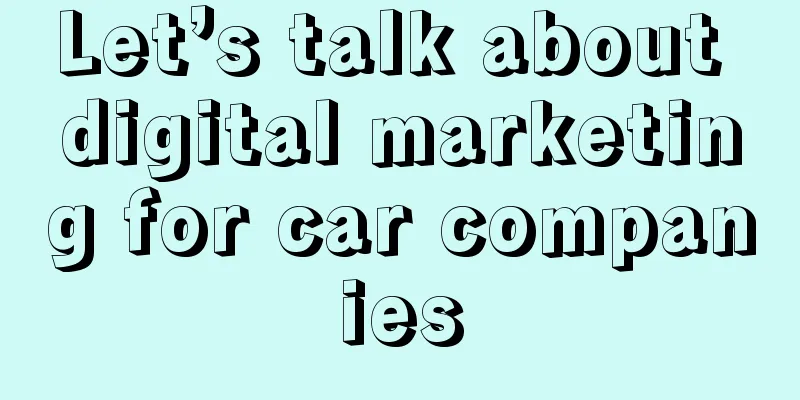Let’s talk about digital marketing for car companies

Today, the overall sales growth rate of China's passenger car market has slowed down, and the market structure has shifted from incremental to stock. The market environment has undergone tremendous changes, competition has intensified, new forces and traditional OEMs are fighting each other fiercely, competing for products, prices, and services... for fear of falling behind in the wave of change. During this period, I have come into contact with some car companies on the market and found that from the perspective of digitalization process and user life cycle operations, there are some common problems. In this article I will talk about some phenomena I have seen and my views on them. 1. Problem1. Data silosCar companies have many departments with dispersed responsibilities. This, coupled with legacy issues in some organizations, leads to data being incompatible between marketing, operations, and sales, resulting in fragmentation and data silos. Take sales as an example: From the perspective of sales conversion , the lack of behavioral data on users in public and private domains will lead to the inability to fully and clearly understand user portraits, product purchasing intentions, and vehicle configuration needs. From the perspective of sales management , there is a lack of effective data tracking of user behavior touchpoints. It is difficult for the headquarters to monitor the communication and conversation records between front-line sales and users, and it is impossible to effectively manage sales behavior, let alone gain insight into users' real needs for products, operations, and services through front-line chats. Lack of data can also lead to a disconnect between headquarters marketing and front-line sales conversion performance . The market can only track the number of leads brought in through channel delivery, but cannot track the quality of each lead and subsequent conversion status. Data can assist in decision making. In particular, data generated after users and brands interact and communicate at various touchpoints can truly start from the brand itself and gain microscopic insights into the real needs of each user. Relying on personal experience to make decisions is sometimes useful, but there will also be path dependence; Making decisions based on market research reports means looking at the problem from the perspective of the grand overall market, which may not necessarily reflect the real needs of one's own users from a brand perspective. With the assistance of data and the combination of the three, we can avoid taking actions that are out of touch with the brand's real users and falling into self-satisfaction in product development, operational decision-making, marketing, and other aspects. 2. High lead cost and low conversion rateIn the past, users came into contact with brands and learned about products through stores, vertical media, official websites and other channels; but with the continuous emergence of major marketing channels, user touchpoints have increased, and attention has become fragmented, coupled with fierce competition among different car companies for advertising. Ultimately, this results in a significant decrease in the proportion of valid leads obtained through channel delivery and an increase in the overall customer acquisition cost. It is difficult to acquire customers, but the conversion rate has not kept up. Most dealers/stores/sales are still using the incremental market practices of the past and making conversions in a rough manner. In order to pursue personal efficiency and maximize profits, front-line sales people lack the motivation to follow up on leads sent by headquarters if the leads do not indicate a short-term intention to purchase a car. They simply ignore the leads , resulting in a large amount of waste of leads acquired at high cost. In terms of lead cultivation and conversion capabilities, different dealers/stores/sales have different knowledge and capabilities, and there are huge gaps; successful experiences and good methods have not been effectively reused. 3. Inconsistent user experienceThe user life cycle of a car company is extremely long, and there are dozens of touchpoints in each stage of pre-sales, sales, and after-sales. Only by spanning the entire user life cycle and cultivating each stage in depth can users have a good experience Frontline sales often lack a macro perspective and only focus on short-term pre-sales conversions. They are extremely enthusiastic about users in the pre-sales stage, and in order to quickly convert them, they will make some excessive promises and even "trick" users. During the delivery and after-sales stages, the customer response is cold and indifferent, with the attitude of “you’d better not bother me”. When users encounter problems, their satisfaction with the solutions is very low, which results in inconsistent user experience. In the past, the market was not saturated and lacked effective competition, so users just swallowed their anger. Today, market competition is fierce, user experience is king, and with the extremely fast spread of social media public opinion , if you still maintain a high position as in the past, it will have an impact on sales that cannot be underestimated. 4. Single profit modelIn the traditional automobile industry chain, the main profit points are the sales, maintenance and repair of complete vehicles related to "cars". However, in today's world where products and prices are highly involuted, the gross profit margins of vehicle sales by OEMs and dealers are low. Therefore, it is necessary to provide a good user experience throughout the entire life cycle, use vehicles as the entry point, and expand business boundaries. 2. Methods1. Connect data from all channelsFirst of all, we need to connect the data of all channel touchpoints. I think this is the most important thing. To make the data connection on the business side exhaustive, without omissions and more efficient, we can first sort out and refine the user's entire life journey from first contact with the brand, product consultation, product purchase, product use, to leaving the brand. A typical user journey for a car company is: awareness, cognition, intention, test drive, decision-making, and payment in the pre-sales stage; waiting for delivery and delivery in the mid-sales stage; and car ownership, maintenance, KOC, and gift and trade-in in the after-sales stage. Based on the sorted out contact characteristics, different data collection methods are matched, such as: API docking of public domain platforms, embedding of private domain platforms, etc. After data collection is integrated into CDP, One ID is formed through ID-mapping to achieve unique identification of users throughout the entire chain. From a business perspective, data connectivity has the following four values: (1) In marketing Gain insights into users’ preferences for channels and content, as well as the behavioral data feedback they take after receiving information, and use this as a basis to create targeted content and deliver it to people with different profiles. When users are in different life cycle stages of pre-sales, sales, and post-sales, their demand for content is different, which can be broken down into dozens of content dimensions. After connecting the data, we can unify marketing information across all touchpoints, including public and private domains, based on the user’s life stage, content needs, and behavioral feedback. For example, for low-intent users in the awareness stage, you can use omni-channel to reach them multiple times to encourage them to test drive; for high-intent users who have already test driven, you can use omni-channel to reach them multiple times to provide preferential policies for making a deposit. (2) In terms of operation Able to design user service systems, growth systems, activity themes, rights incentives, cross-industry cooperation and other strategies based on user needs and feedback. (3) In sales Through user behavioral feedback when they come into contact with brand touchpoints, we generate clear insights into user portraits and needs, so that front-line sales can give targeted product recommendations, price benefits, and service strategies. (4) On the product Clearly understand users' real needs for products, thereby feeding back to the product R&D and design of the supply chain and driving sales planning of product lines. 2. Headquarter-centralized lead cultivationFor their own benefit, frontline sales will selectively give up temporary low-quality leads sent by the headquarters. For this, the headquarters can set up a centralized lead cultivation team. Users attracted by marketing are centrally operated through unified linkage through corporate WeChat, APP, SMS and other touch points. After high-potential users who meet the standards and are interested in buying or test driving are incubated, the leads are transferred to front-line sales for service and conversion. After breaking down and dividing the business processes of marketing and conversion, I think there are three benefits: (1) Avoid wasting leads All leads are incubated and screened uniformly by the headquarters. Even low-quality leads that have no temporary intention to buy a car can be effectively nurtured. (2) Improved business efficiency The headquarters can sort out the optimal incubation SOP for cultivating low-quality leads into high-quality leads based on the experience and skills of front-line sales conversions and feedback from user behavior data. Effectively reuse successful experiences and good methods, and achieve cost reduction and efficiency improvement through MA marketing automation. Stores/sales only need to provide warm service and serve the high-quality leads sent by the headquarters well and attentively; saving the cost and energy of screening and cultivating leads. (3) Clear division of responsibilities to avoid disputes The responsibilities of marketing customer acquisition and sales conversion are divided through division of labor. It can effectively prevent sales from attributing good conversion data to themselves and blaming bad conversion data on the headquarters marketing end. From the market delivery side, we can also do a good job of performance attribution, clearly understand the leads generated through front-end delivery, and the final back-end conversion performance, and use this to adjust the front-end delivery strategy; we can also be more reasonable and well-founded when asking for budgets and doing performance appraisals from superior organizations. 3. Long-term focus on user developmentCompared with the one-way marketing input of traditional brands, nowadays, users prefer to obtain brand-related information through two-way word-of-mouth from social groups and word-of-mouth recommendations from KOCs and KOLs. Therefore, user operations should not be limited to a single pre-sales conversion, but should be based on the perspective of the user's entire life cycle, providing services that exceed expectations before, during, and after sales. In the pre-sales stage, we will unify the pricing across all channels and avoid excessive promises or false advertising. During the sales stage, we will do a good job in reporting progress, controlling public opinion, interpreting policies, handling formalities, providing process services, and teaching/promoting vehicle functions from placing an order, waiting for delivery, to delivery. In the after-sales stage, we will ensure the onboarding of new car owners, the convenience of after-sales/charging processes, and the experience of car owners in online/offline activities. Create resonance between users and users, and between users and brands, thereby promoting the discovery and cultivation of KOCs belonging to the brand. There are three common ways to mine KOCs:
After KOC is discovered, cultivated, and operated, there are four major benefits for brands:
4. Expand the boundaries of profitable businessThe gross profit margin of vehicle sales is extremely low due to internal circulation. Therefore, through the above-mentioned long-term approach of deeply cultivating users and taking car sales as the starting point, the boundaries of profitable business in the automotive aftermarket can be broadened. for example:
In fact, compared with specific operational methods, I think what is more difficult in implementation are the barriers between organizations and the distribution of interests between departments. Auto companies have many departments and highly segmented functions, and each major operational action needs to be coordinated with the organizations of various departments. Without the approval of the top management and personal leadership, a single department will be responsible for promoting it, and there will be many obstacles. It will be difficult to show obvious operational results, or it will only remain on the PPT. Author: Chen Sanshi Source: Public Account: Tomato Operation |
<<: Australia's new "top streamer" tells a "new story" about outbound travel
>>: Why does “consumer society” require “endless desire”?
Recommend
After this update of Station B, movie commentators can no longer bear it
After experiencing the copyright storm and the &qu...
Can Chinese people buy things on etsy? How to buy things?
The things on the Etsy platform are all very perso...
What is a scenario? Define the "field" power of the product!
In business and product design, the word "sce...
How to file a complaint against a merchant on Amazon? What is the method?
Many people like to shop on the Amazon platform. O...
Who pays for Amazon's self-fulfillment of orders? How to handle Amazon's self-fulfillment of orders?
Sellers on the Amazon platform can now choose the ...
What are the cross-border e-commerce logistics? Introduction to the four major models
I believe everyone knows how popular the cross-bor...
Is there any interest on a one-time credit card repayment? How to repay a one-time credit card repayment?
As an important tool for modern consumer life, cre...
Douyin joins the e-commerce platform "Hourly Delivery", and instant delivery is open!
In today's fierce competition among e-commerce...
Why is my eBay account frozen? What should I do if my eBay account is abnormal?
Having your eBay account frozen is very difficult ...
What is the difference between Amazon's order volume and sales volume? Is sales volume the monthly sales volume?
If you are a novice doing business on Amazon, you ...
30 years of Internet recruitment: a war for efficiency
Internet companies are not only competing fiercely...
How to ship with Shopee local account? How to do it?
Shopee stores are divided into two types: cross-bo...
If brands want to do well on Xiaohongshu, they must understand these logics!
This article will explain how to effectively promo...
Selling 10 million in one day, understanding this generation of young people starts with "eyeballs"
In the new consumption era, young people's con...
Why do reaction videos become popular when foreigners listen to Chinese music?
As reaction videos become more popular, people can...









